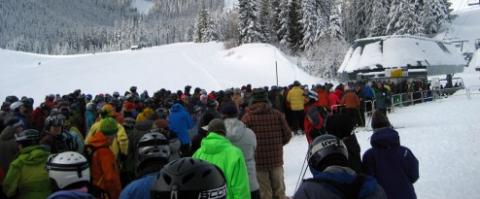
They spent almost an hour in line, yet more and more skiers came, bonding as they waited . . . and waited.
Beginning after World War II and for the next 40 years, weekend skiers waited in lift lines so long that the person next to you had time to describe where he was born, his best powder day, his favorite music, why he deserved a promotion at the office, and . . . hey, look at that babe in the Bogner pants. Waiting could last an hour, all for a 12-minute ride up the mountain and the reward of a quick descent.
The problem of egregious lift queues, exasperating and bone-freezing, arose from the relentless supply of young babyboomers demanding to ski. Their numbers exceeded the growth of new ski areas and lifts, even though that growth itself was spectacular. In the ten-year period between 1956 and 1966 alone, more than 580 ski areas with chairlifts and T-bars came into being, many of them previously equipped with rope tows. Yet it wasn’t enough. The number of U.S. skiers quintupled in the same period. And when a million or more of them arrived at the bottom of the mountain on a Saturday morning, the place looked like a standing-room-only Beatles concert. Waits of 45 minutes and more were common across the country, from Stowe to Boyne to Big Bear.
Some relief arrived with the advent of triple and quadruple seated lifts, but the big breakthrough came in the 1980s with the engineering of the detachable chair. Climbing speed doubled. Time-wasting mishaps in boarding the lifts were sharply reduced. The new chairs and gondolas were people-eaters. In the last five years of the 20th Century alone, North American ski resorts installed 250 lifts capable of carrying more people uphill than all of the lifts that existed in the winter of 1965-66!
In the 1950s and 1960s, observed writer Morten Lund, lift lines allowed enough time “to meet a member of the opposite sex, get infatuated, engaged and plan the wedding.” Today, a Saturday or Sunday lift line scarcely allows time to work up an après-ski date. While no one wants to regress to long queues and slow lifts, history suggests that they once helped to develop skiing’s reputation as a sociable sport.
